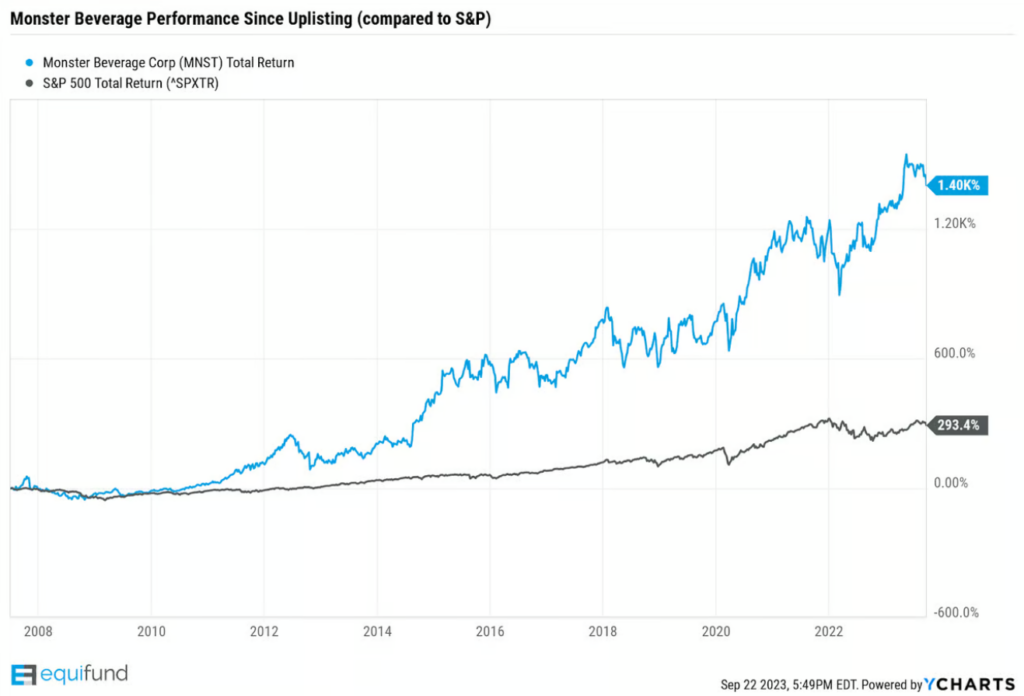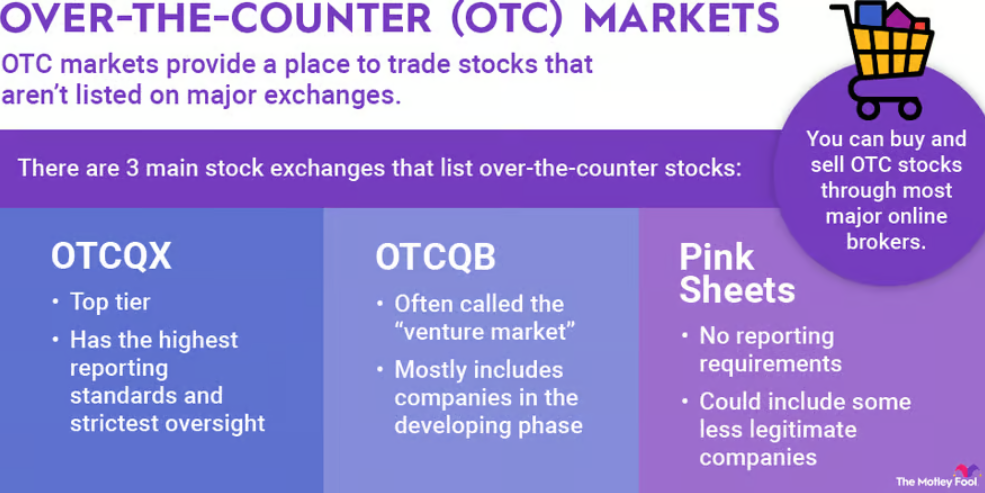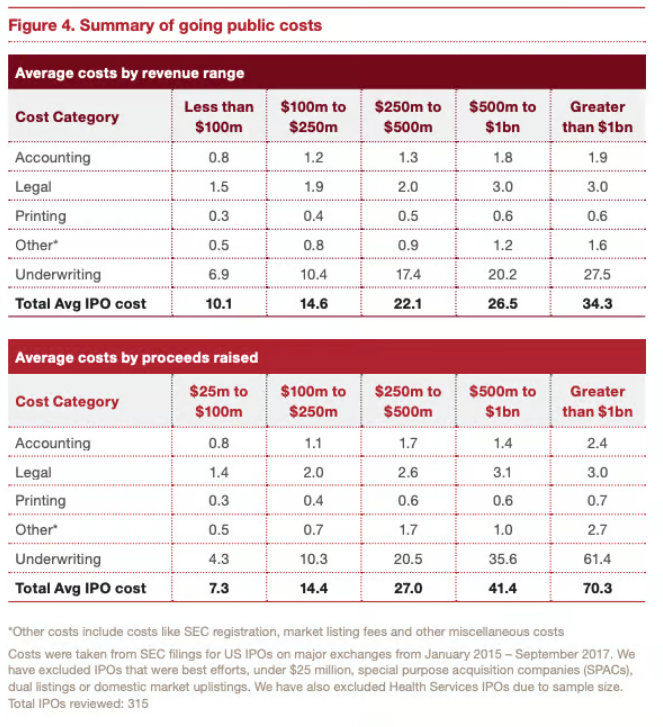Uplisting (sometimes referred to as a second IPO) is when a stock transitions from a junior stock exchange to a major one – for example, from the OTC markets to the Nasdaq or New York Stock Exchange.
A famous example of a stock that experienced a post-uplisting surge is the energy drink company, Monster Beverage (Nasdaq: MNST) – one of the largest beverage companies in the world, boasting over $6 billion in annual revenue.
MNST made its public debut in 1990. On July 5th, 2007, it announced that its shares would be traded on the Nasdaq Global Select. From that point onwards, the stock has risen approximately 1,400% (compared to the S&P Total Return’s 293%).

In this blog post, we’ll discuss the ins and outs of how the uplisting process works, and how investors can seek to profit from stocks going through an uplisting.
Key Takeaways:
Uplisting Definition: Uplisting is when a stock transitions from a junior exchange like the OTC markets to a major one, such as Nasdaq or NYSE.
Benefits of Uplisting: Uplisting can potentially increase analyst coverage, trading volume, and reduce costs of capital for companies.
Risks of Penny Stocks: Penny stocks, often found on junior exchanges, carry significant risks including high investment risk and liquidity risk.
Potential Profits from Uplisting: Stocks that successfully uplist could see significant growth, but this is not guaranteed and depends on various factors.
Finding Uplisting Stocks: Investors can identify potential uplisting stocks through company announcements, financial health analysis, and monitoring listing requirements.
Why Companies Uplist
You might think it’s a potentially profitable idea to buy cheap stocks priced under $5, but most investors don’t understand that buying penny stocks comes with significant risks. Not only are these small companies typically high-risk investments, they typically don’t have much trading volume.
This lack of trading volume creates what is called Liquidity Risk – where a seller may be willing to sell, but can’t because either:
There aren’t any buyers willing to buy
Buyers aren’t willing to buy at the seller’s desired price
For this reason, some companies that trade Over the Counter decide they want to “uplist” their stock to a Senior Exchange – like the Nasdaq or New York Stock Exchange – to potentially get access to more analyst coverage, more trading volume, and cheaper costs of capital.
This increase in “liquidity” has the benefit of decreasing the space, or “spread”, between the bid price and the asking price. This in turn attracts more buyers and sellers to the stock, which may lead to better long-term price appreciation.

The more buyers and sellers that participate in each venue, the easier it is to match buy orders (the “bid”) and sell orders (the “ask”) at the price people want to pay.
And for investors looking to profit, these uplisted stocks may provide an opportunity to make outsized returns in a relatively short period.
How Much Money Can I Make From an Uplist?
According to a study published in the April 2021 issue of The Financial Review, companies see a significant increase in their stock liquidity after making the move from an alternative stock exchange to a major exchange.
Compared to the study’s control firm, the average “treatment” firm experiences an 80.21% increase in dollar volume, a decrease in bid-ask spreads by 143 basis points (bps), and a roughly 36% reduction in price impacts.
Admittedly, the study only examines the 190 “treatment” stocks over a 120-day period around the uplisting date, and doesn’t touch upon the long-term effects on volume or pricing. For this data, we’ll turn to a series of articles published by Sergio Heiber on the effect uplisting has on stock prices.
Long-Term Uplisting Stock Performance
Sergio Heiber’s various studies used stocks that were uplisted from OTC to a senior exchange in 2015 – 2018. Heiber’s analysis of the 2017 and 2018 samples reveals:
-
Approximately 68% of stocks that were uplisted experienced a 26% average price surge in the six months leading up to the uplisting.
-
However, gains seems to be short-lived, as most stocks had 16% lower prices than their uplist price within a year.
Biotech stocks were the most volatile, while Material stocks showed the least volatility.
To sum it up, a stock undergoing a successful uplist could experience tremendous growth, akin to Monster Beverage—especially if it continues to achieve corporate milestones and attract institutional and retail investors.
But to be clear, uplisting a stock from the OTC to a Senior Exchange doesn’t magically create analyst coverage, build sustainable trading volume, and unlock capital all on its own.
Just like any other product or service, the stock needs to be marketed to the right audience in the right way. And for this reason, if you’re a retail investor aiming to add this typically “Insiders Only” investment to your self-directed IRA, it’s crucial to understand the inner workings of the different minor and major stock exchanges first.

How the Stock Market Works
To have a better idea of when your pre-ipo investment is going public, you need to know the requirements for going public and staying public.
The “stock market” is a broad term that refers to different trading venues (ie Exchanges) where investors can go to buy and sell different securities.
Types of Stock Exchanges
In the U.S., the stock market can be largely divided into two categories:
Over The Counter (OTC) markets
Senior Exchanges – like the New York Stock Exchange and Nasdaq
OTC Markets are home to more than 10,000 companies – both domestic and foreign – who want to access the U.S. market at a lower cost than they could on a Senior Exchange, and with minimal financial or regulatory requirements.

The 3 main OTC stock exchanges. Image source: Motley Fool
The Nasdaq and NYSE are home to more than 6,000 companies. Similar to the OTC markets, both the Nasdaq and NYSE have different “tiers” companies can list their stock on.
Nasdaq has three tiers – venture, select, global. NYSE has two – NYSE American, NYSE Global
So why would a publicly traded company seeking to undergo a “second IPO” on a major exchange choose one over the other? Most often, the answer is a combination of price, minimum listing requirements, and status/prestige.
The Cost of Going Public
Once you factor in all the costs associated with going public – most notably, underwriting, accounting, and legal – it gets expensive. Underwriting makes up the largest component of IPO costs, by far (generally 4% to 7% of the gross proceeds of the IPO).

Summary of going public costs. Source: PWC
In PwC’s recent survey, two-thirds of the public company CFOs estimated spending upwards of $1.9 million annually on the costs of being public.
For this reason, many smaller companies that either don’t meet the listing requirements – or don’t want to assume those costs – will choose to instead go public on the OTC market.
According to Colonial Stock Transfer, it can cost between $6,000 and $28,000 (depending on the OTC tier) to go public on the OTC markets.
How to Find Stocks That Are Going to Uplist
Finding stocks that are on the verge of uplisting requires careful analysis and monitoring of the market. Here are some steps you can follow:
-
Company Announcements: Companies often announce their intentions to uplist in their press releases, SEC filings, or during earnings calls. Keeping a close eye on these sources can provide early hints.
-
Financial Health: Companies aiming to uplist usually have stable financials. Look for companies with consistent revenue growth, strong balance sheets, and positive cash flow.
-
Meeting Listing Requirements: Each major exchange has specific listing requirements, including minimum share price, net income, shareholders’ equity, and more. Companies that are progressively meeting these criteria might be preparing for an uplisting.
-
Hiring New Advisors or Underwriters: If a company hires a new financial advisor or underwriter, it may be preparing for the transition to a major exchange.
-
Industry Forums and News: Participate in financial forums and follow financial news platforms. These sources often discuss potential uplisting stocks.
-
Regulatory Compliance: Companies that are consistently compliant with regulatory requirements are more likely to be considering an uplist.
Remember, while uplisting can lead to significant gains, these stocks also carry significant liquidity and price risks. Always do your due diligence before investing in an uplisting stock.

Frequently Asked Questions?
What does uplisting a stock mean?
Uplisting a stock means elevating it from an alternative trading platform like the OTC Markets, TSX or ASX to the NASDAQ or NYSE (New York Stock Exchange).
Do stocks go up after uplisting?
Studies show that stocks generally experience an increase in price up to six months after being uplisted. 68% of the uplisted stocks experienced a stock price appreciation during that time, with an average increase of 26%.
What happens when a stock gets uplisted to Nasdaq?
Uplisting to NASDAQ can significantly increase trading volumes and liquidity for a company’s stock, making it more attractive to institutional investors. This may result in increased share prices and less short-term volatility.
What are the main differences between OTC markets and major exchanges like NASDAQ and NYSE?
OTC markets are less regulated and cater to smaller public companies, while major exchanges like NASDAQ and NYSE have higher trading volumes and offer more visibility and liquidity for listed companies.
What challenges and risks are involved in the uplisting process?
Uplisting involves a host of challenges and risks, such as meeting new requirements, sustaining share prices, adhering to financial reporting deadlines, and instituting solid reporting and corporate governance standards and practices.
Want to learn more about investing in private market deals?
Here at Equifund, we help investors access early-stage opportunities not found anywhere else.






